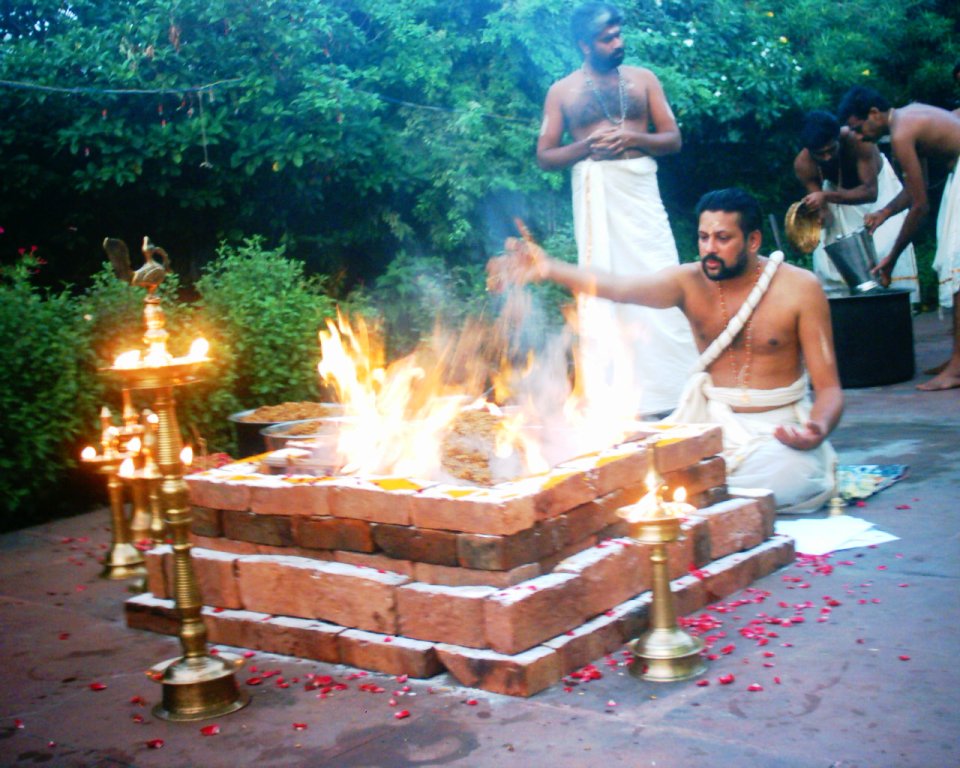|
Yajña
In Hinduism, ''Yajna'' or ''Yagna'' (, ɐd͡ʒɲə ) also known as Hawan, is a ritual done in front of a sacred fire, often with mantras. Yajna has been a Vedic tradition, described in a layer of Vedic literature called Brahmanas, as well as Yajurveda. The tradition has evolved from offering oblations and libations into sacred fire to symbolic offerings in the presence of sacred fire (Agni). Yajna rituals-related texts have been called the ''Karma-kanda'' (ritual works) portion of the Vedic literature, in contrast to the ''Jnana-kanda'' (knowledge) portion found in the Vedic Upanishads. The proper completion of Yajna-like rituals was the focus of Mimansa school of Hindu philosophy. Yajna have continued to play a central role in a Hindu's rites of passage, such as weddings. Modern major Hindu temple ceremonies, Hindu community celebrations, or monastic initiations may also include Vedic Yajna rites, or alternatively be based on Agamic rituals. Etymology The word ''yajna'' ... [...More Info...] [...Related Items...] OR: [Wikipedia] [Google] [Baidu] |
Brihadaranyaka Upanishad
The ''Brihadaranyaka Upanishad'' (, ) is one of the Mukhya Upanishads, Principal Upanishads and one of the first Upanishadic scriptures of Hinduism. A key scripture to various schools of Hinduism, the ''Brihadaranyaka Upanisad'' is tenth in the Muktikā or "canon of 108 Upanishads". The ''Brihadaranyaka Upanishad'' is estimated to have been composed about 7th–6th century BCE, excluding some parts estimated to have been composed after the ''Chandogya Upanishad''. The Sanskrit language text is contained within the ''Shatapatha Brahmana'', which is itself a part of the Yajurveda#Shukla Yajurveda, Shukla Yajur Veda. The ''Brihadaranyaka Upanishad'' is a treatise on Ātman (Hinduism), Ātman (Self), includes passages on metaphysics, ethics, and a yearning for knowledge that influenced various Indian religions, ancient and medieval scholars, and attracted secondary works such as those by Adi Shankara and Madhvacharya. Chronology The chronology of ''Brihadaranyaka Upanishad'', like o ... [...More Info...] [...Related Items...] OR: [Wikipedia] [Google] [Baidu] |
Vedas
FIle:Atharva-Veda samhita page 471 illustration.png, upright=1.2, The Vedas are ancient Sanskrit texts of Hinduism. Above: A page from the ''Atharvaveda''. The Vedas ( or ; ), sometimes collectively called the Veda, are a large body of religious texts originating in ancient India. Composed in Vedic Sanskrit, the texts constitute the oldest layer of Sanskrit literature and the oldest Hindu texts, scriptures of Hinduism. There are four Vedas: the Rigveda, the Yajurveda, the Samaveda and the Atharvaveda. Each Veda has four subdivisions – the Samhitas (mantras and benedictions), the Brahmanas (commentaries on and explanation of rituals, ceremonies and sacrifices – Yajñas), the Aranyakas (text on rituals, ceremonies, sacrifices and symbolic-sacrifices), and the Upanishads (texts discussing meditation, philosophy and spiritual knowledge).Gavin Flood (1996), ''An Introduction to Hinduism'', Cambridge University Press, , pp. 35–39A Bhattacharya (2006), ''Hindu Dharma: Introduc ... [...More Info...] [...Related Items...] OR: [Wikipedia] [Google] [Baidu] |
Avestan Language
Avestan ( ) is the liturgical language of Zoroastrianism. It belongs to the Iranian branch of the Indo-European language family and was originally spoken during the Old Iranian period ( – 400 BCE) by the Iranians living in the eastern portion of Greater Iran. After Avestan became extinct, its religious texts were first transmitted orally until being collected and put into writing during the Sasanian period ( – 500 CE). The extant material falls into two groups: Old Avestan ( – 900 BCE) and Younger Avestan ( – 400 BCE). The immediate ancestor of Old Avestan was the Proto-Iranian language, a sister language to the Proto-Indo-Aryan language, with both having developed from the earlier Proto-Indo-Iranian language. As such, Old Avestan is quite close in both grammar and lexicon to Vedic Sanskrit, the oldest preserved Indo-Aryan language. Name The Avestan texts consistently use the term Arya, i.e., Iranian, for the speakers of Avestan. The same term also app ... [...More Info...] [...Related Items...] OR: [Wikipedia] [Google] [Baidu] |
Jñāna
In Indian philosophy and religions, ' (, ) is "knowledge". The idea of ''jñāna'' centers on a cognitive event which is recognized when experienced. It is knowledge inseparable from the total experience of reality, especially the total or divine reality (Brahman). There are also some categorised terms like physical ''Jñāna,'' spiritual ''Jñāna'' and ultimate ''Jñāna'' of Self-Realisation. Etymology ''Jñāna'' sometimes transcribed as ''gyaan'', means "knowledge" in Sanskrit. The root ज्ञा- '' jñā-'' is cognate to Slavic znati, English '' know'', Greek γνώ- (as in γνῶσις ''gnosis''), and Lithuanian žinoti. Its antonym is अज्ञान ''ajñāna'' "ignorance". In Buddhism In Tibetan Buddhism, ''jñāna'' (Tibetan: ''ye shes'') refers to pure awareness that is free of conceptual encumbrances, and is contrasted with '' vijñāna'', which is a moment of 'divided knowing'. Entrance to, and progression through the ten stages of ''jñāna'' (Bod ... [...More Info...] [...Related Items...] OR: [Wikipedia] [Google] [Baidu] |
Karma Kāṇḍa
Karma Kāṇḍa (Sanskrit: कर्मकाण्ड) refers to the section of the Vedas that lists the performance of rituals and sacrificial rites for material benefits or to acquire values that will lead to liberation, which are performed by anyone without exchange for a Dakshina. See also * Dharma * Karma * Maya * Bhagavad Gita * Hinduism * Brahmin Brahmin (; ) is a ''Varna (Hinduism), varna'' (theoretical social classes) within Hindu society. The other three varnas are the ''Kshatriya'' (rulers and warriors), ''Vaishya'' (traders, merchants, and farmers), and ''Shudra'' (labourers). Th ... References Rituals in Hindu worship {{Hindu-stub ... [...More Info...] [...Related Items...] OR: [Wikipedia] [Google] [Baidu] |
Deva (Hinduism)
''Deva'' (, ) means 'shiny', 'exalted', 'heavenly being', 'divine being', 'anything of excellence', and is also one of the Sanskrit terms used to indicate a deity in Hinduism.Monier Monier-Williams, A Sanskrit-English Dictionary” Etymologically and Philologically Arranged to cognate Indo-European Languages, Motilal Banarsidass, page 492 ''Deva'' is a masculine term; the feminine equivalent is ''Devi (Hinduism), Devi''. The word is a cognate with Latin ''deus'' ('god') and Greek Zeus. In the earliest Vedic literature, all supernatural beings are called ''Devas''George Williams (2008), A Handbook of Hindu Mythology, Oxford University Press, , pages 90, 112 and ''Asuras''. The concepts and legends evolved in Indian literature#In archaic Indian languages, ancient Indian literature, and by the late Vedic period, benevolent supernatural beings are referred to as ''Deva-Asuras''. In post-Vedic Hindu texts, such as the Puranas and the Itihasas of Hinduism, the ''Devas'' represent the g ... [...More Info...] [...Related Items...] OR: [Wikipedia] [Google] [Baidu] |
Shvetashvatara Upanishad
The ''Shvetashvatara Upanishad'' (, ) is an ancient Sanskrit text embedded in the Yajurveda. It is listed as number 14 in the Muktika canon of 108 Upanishads. The Upanishad contains 113 mantras or verses in six chapters.Robert Hume (1921)Shvetashvatara Upanishad The Thirteen Principal Upanishads, Oxford University Press, pages 394–411 with footnotes The Upanishad is one of the 33 Upanishads from Taittiriyas, and associated with the ''Shvetashvatara'' tradition within ''Karakas sakha'' of the Yajurveda. It is a part of the "black" "krishna" Yajurveda, with the term "black" implying "the un-arranged, motley collection" of content in Yajurveda, in contrast to the "white" (well arranged) Yajurveda where Brihadaranyaka Upanishad and Isha Upanishad are embedded. The chronology of Shvetashvatara Upanishad is contested, but it is generally accepted to be a late-period Upanishadic composition.Stephen Phillips (2009), Yoga, Karma, and Rebirth: A Brief History and Philosophy, Columbia ... [...More Info...] [...Related Items...] OR: [Wikipedia] [Google] [Baidu] |
Yoga
Yoga (UK: , US: ; 'yoga' ; ) is a group of physical, mental, and spiritual practices or disciplines that originated with its own philosophy in ancient India, aimed at controlling body and mind to attain various salvation goals, as practiced in the Hindu, Jain, and Buddhist Buddhism, also known as Buddhadharma and Dharmavinaya, is an Indian religion and List of philosophies, philosophical tradition based on Pre-sectarian Buddhism, teachings attributed to the Buddha, a wandering teacher who lived in the 6th or ... traditions. Yoga may have pre-Vedic period, Vedic origins, but is first attested in the early first millennium BCE. It developed as various traditions in the eastern Ganges basin drew from a common body of practices, including Vedas, Vedic elements. Yoga-like practices are mentioned in the ''Rigveda'' and a number of early Upanishads, but systematic yoga concepts emerge during the fifth and sixth centuries BCE in ancient India's sannyasa, ascetic and ... [...More Info...] [...Related Items...] OR: [Wikipedia] [Google] [Baidu] |
Chandogya Upanishad
The ''Chandogya Upanishad'' (Sanskrit: , IAST: ''Chāndogyopaniṣad'') is a Sanskrit text embedded in the Chandogya Brahmana of the Sama Veda of Hinduism.Patrick Olivelle (2014), ''The Early Upanishads'', Oxford University Press; , pp. 166-169 It is one of the oldest Upanishads. In the Muktika canon of 108 Upanishads, it is listed as the ninth. The Upanishad belongs to the ''Tandya'' school of the Samaveda. Like ''Brihadaranyaka Upanishad'', the Chandogya is an anthology of texts that must have pre-existed as separate texts, and were edited into a larger text by one or more ancient Indian scholars. The precise chronology of ''Chandogya Upanishad'' is uncertain, and it is variously dated to have been composed by the 8th to 6th century BCE in India. As one of the most extensive Upanishadic compilations, it comprises eight ''Prapathakas'' (literally 'lectures' or 'chapters'), each divided into multiple sections containing numerous verses. The volumes include a diverse array of ... [...More Info...] [...Related Items...] OR: [Wikipedia] [Google] [Baidu] |
Atman (Hinduism)
Atman or Ātman may refer to: Religion * Ātman (Hinduism), ''Ātman'' (Hinduism), meaning "Self", a philosophical concept common to all schools of Hindu philosophy * Ātman (Buddhism), ''Ātman'' (Buddhism), ''attā'' or ''attan'', a reference to the essential self ** ''Anattā'' or ''anātman'' — "not-self", central concept in Buddhism * Ātman (Jainism), ''Ātman'' (Jainism), or ''Jīva'', a philosophical term used within Jainism to identify the soul * ''Atman jnana'' — "knowledge" in the context of Indian philosophy and religions Film * Ātman (1975 film), ''Ātman'' (1975 film), a Japanese experimental short film directed by Toshio Matsumoto * Atman (1997 film), ''Atman'' (1997 film), a documentary film directed by Pirjo Honkasalo People * Cynthia Atman, American engineer * Pavel Atman (born 1987), Russian handball player See also * Ataman, a title of Cossack and haidamak leaders of various kinds * Atma (other) * Atta (other) * Divine soul (disambi ... [...More Info...] [...Related Items...] OR: [Wikipedia] [Google] [Baidu] |
Vedanga
The Vedanga ( ', "limb of the Veda-s"; plural form: वेदाङ्गानि ') are six auxiliary disciplines of Vedic studies that developed in Vedic and post-Vedic times.James Lochtefeld (2002), "Vedanga" in The Illustrated Encyclopedia of Hinduism, Vol. 1: A-M, Rosen Publishing, , pages 744-745 List of the Vedanga #Shiksha (Sanskrit: शिक्षा ', "instruction, teaching"): phonetics, phonology, pronunciation. This auxiliary discipline has focused on the letters of the Sanskrit alphabet, accent, quantity, stress, melody and rules of euphonic combination of words during a Vedic recitation. # Chanda (Sanskrit: छन्द ', "metre"): prosody.James Lochtefeld (2002), "Chandas" in The Illustrated Encyclopedia of Hinduism, Vol. 1: A-M, Rosen Publishing, , page 140 This auxiliary discipline has focused on the poetic meters, including those based on fixed number of syllables per verse, and those based on fixed number of morae per verse. # Vyakarana (Sanskrit: व्� ... [...More Info...] [...Related Items...] OR: [Wikipedia] [Google] [Baidu] |







